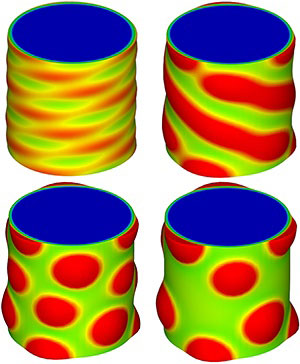| Jun 22, 2011 |
New study explores morphological evolution of a core-shell nanowire
|
|
(Nanowerk News) Stress can cause a material to change shape, and the degree of deformation is known as strain. Far from being a nuisance, strain is actually a critical parameter in the growth and morphological evolution of nanostructures, and its control is essential for producing the desired optical and electronic properties in both one- and two-dimensional materials.
|
|
The surface of stressed thin film, for example, is known to develop an array of nanoscopic 'islands' in way that minimizes surface strain. This phenomenon, known as Asaro–Tiller–Grinfeld (ATG) instability, is interesting and useful because it provides a simple means of forming tiny crystalline grains, or 'quantum dots', of a variety of semiconductor materials.
|
 |
| Morphological evolution of a core-shell nanowire with an initial helical perturbation. (© 2011 ACS)
|
|
Apart from thin films, stressed nanowires can also experience ATG instability. Several groups have recently reported the growth of quantum dots on the surface of 'core–shell' nanowires—either germanium-coated silicon nanowires or silicon-coated germanium nanowires. The stress in these systems is caused by structural mismatch between the core and shell as they are coherently bonded together. A few groups have performed preliminary simulations to study the formation process, but the approximations used are only good for predicting the early stage of morphological evolution, when the amplitude of surface undulations is small.
|
|
Jun-Yan Guo at the A*STAR Institute of High Performance Computing and co-workers have now developed a three-dimensional dynamical simulation framework for studying the growth of nanostructures on the surface of core–shell nanowires ("Morphological Evolution and Ordered Quantum Structure Formation in Heteroepitaxial Core-Shell Nanowires"). Three-dimensional dynamic simulations allow stress–strain analysis to be performed and morphological evolution to be predicted without resorting to approximations of their sizes and shapes.
|
|
The researchers used their simulation to show that the type of nanostructures formed on a nanowire surface subjected to heat treatment (annealing) depends largely on the initial mode of perturbation and geometric parameters. Helical perturbations, for example, initially cause helical ridges to form on the nanowire surface (see image). These ridges then break up to form an array of quantum dots that are evenly distributed in a helical pattern.
|
|
Quantum dots are not the only type of nanostructure that can form on the nanowire surface. Given the right conditions—and sometimes with the help of surface prepatterning—rings and filaments can also form.
|
|
The finding is important because it provides a means to design highly ordered nanostructures. The technique is expected to open up opportunities for the fabrication of novel photonic and electronic devices, such as energy-efficient nanowire-based solar cells.
|

